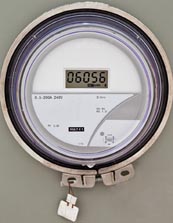BY RAMANAN NATARAJAN
Product Marketing Manager
Texas Instruments, www.ti.com
Deployment of smart energy meters is in full swing worldwide. Traditionally, consumers like me and you pay only for the kWh we consumed for all the electrical equipment in our homes. However, for all equipment without power factor correction (PFC), the energy draw from the electrical outlet is, in fact, much higher. It is more correctly represented by kVAh (kilovolt-amp-hour), which is not affected by the voltage-current phase differences. The cost of this incorrect measurement is graciously borne by our friendly neighborhood utility company.
Smart meters can measure both the kWh we consume and kVAh that the utility company actually delivers. Beware — these smart devices are in a position to expose our bad consuming habits. We'd better get that power factor corrected quickly, lest the utility companies decide to come at us with vengeance for their pound of flesh.
One way to protect ourselves from this vengeance is using a power factor controller (PFC). One example of a number of ICs available for this task would be TI's UCC28180 PFC controller. These controllers use a boost topology operating in continuous conduction mode (CCM), which lends itself to a wide range of power levels, from a few hundred watts to several kilowatts. This type of controller can be applied to a broad variety of equipment in home and office such as TVs, air conditioners, wide-area lighting, projectors, workstations, and in industrial/IT infrastructure environments to such things as power supplies for process automation, programmable logic controllers, datacenter servers, and cellular base stations.

Fig. 1: Smart meters measure both the kWh and kVAh.
Active and passive PFC
Active PFC control uses switch mode power conversion, while passive PFC involves simply inserting good old inductors and capacitors, at the front end of electrical equipment. Although component count may be higher, there is huge savings in overall equipment cost, size, weight, and even manufacturing costs by moving from passive to active PFC.
A classic example is in a commercial multi-kW air-conditioner. In this instance, the size and weight of the passive PFC inductor is so huge, you have to bolt it to the chassis and add a wire harness to connect it to rest of the electronics driving the main compressors and motors. Adopting an active approach, using high-frequency switching, the size and weight of the inductor shrinks and results in significantly reduced magnetics cost. From a mechanical design perspective, the inductor can easily mount directly onto the main electronics board, reducing special assembly costs.
Having the capability to program the exact switching frequency provides the flexibility to optimize the design for size, cost, efficiency and specific choice of power switch (MOSFET, IGBT etc). Many controllers can operate at a low switching frequency of 18 kHz, which facilitates using high-current IGBT power switches which deliver superior performance compared to power MOSFETs in the multi-kW range. For new power devices such as SiC MOSFETs and GaN HEMTs that are on the horizon, the newest controllers support switching frequencies as high as 250 kHz. This allows you to harness the promise of these wide band-gap power semiconductors which are able to achieve the 50+ W/in3 and 98% efficiency for the holy grail of power conversion.
Total harmonic distortion
Total harmonic distortion (THD) is a much desired performance metric these days. This parameter represents what fraction of the fundamental AC input line current harmonic is represented by all the rest of the harmonics combined. Measured as a percent of the fundamental harmonic, the goal is to keep this metric as low as 5% to 10%, especially when the equipment is consuming significant power — 50% to 100% of nameplate power rating.
In equipment powered by a UPS, the PFC must extend down to as low as 10% to 20% of nameplate power rating. If the equipment tends to dwell at these load conditions for a prolonged period, the need for low THD at low power may be especially important. UPS face a difficult task in delivering a well regulated ac output under a light, high THD load. A classic example of this situation is a datacenter server power supply that may be idling at light load conditions for several hours during the night.

Fig. 2: Power factor and THD correction achieved using the UCC28180 PFC IC.
With many analog PFC controllers available in the industry today, low THD is achievable only when a strong current-sensing signal is supplied to this type of design. This implies using a high-value current measurement shunt resistor, especially at light loads. That higher-value resistor means more losses and lower efficiency. Using available continuous conduction mode PFC controllers, like the UCC28180, allows for a lower-value resistor. With these sorts of controllers, THD as low as 5% is achieved with shunt resistance that is 50% lower in value (see Fig. 2 ).
Now — go forth and get that “power factor” corrected! This information originally appeared on the TI Power House blog (e2e.ti.com/blogs_/b/powerhouse/default.aspx).
Advertisement
Learn more about Texas Instruments





